Beaumont, TX Pollen and Allergy Report for Summer 2023
Pollen Allergy Trends in Beaumont, TX
When is pollen lowest in Beaumont, TX?

February
Lowest month total PPM
Avg. PPM
When is pollen highest in Beaumont, TX?

March
Highest month total PPM
Avg. PPM
How does pollen in Beaumont, TX compare to Texas?
Beaumont has a higher average PPM than the state of Texas.
Beaumont yearly avg PPM:
Texas yearly avg PPM:
How does pollen in Beaumont, TX compare to the USA?
Beaumont has a higher average PPM than the USA.
Beaumont yearly avg PPM:
USA yearly avg PPM:
Is pollen worse this year in Beaumont, TX?
Spring 2023 was worse than spring 2022.
Spring 2023 PPM:
Spring 2022 PPM:
Average PPM in Beaumont, TX
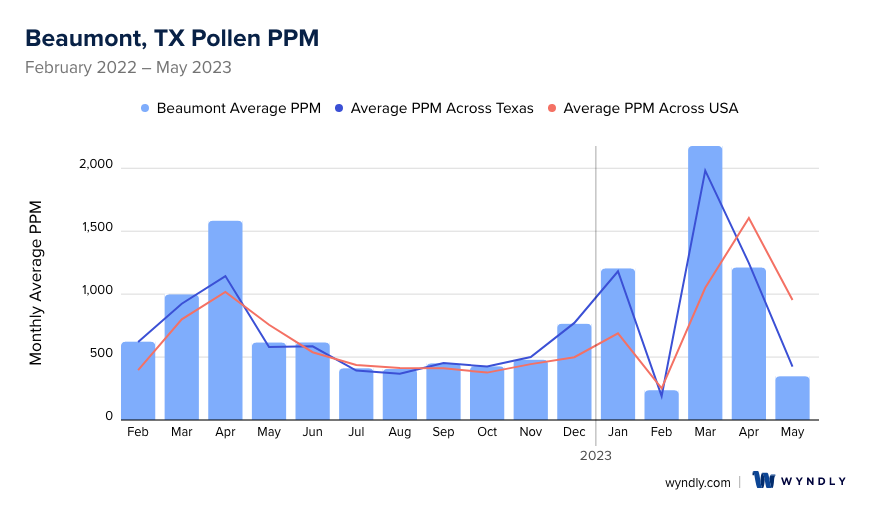
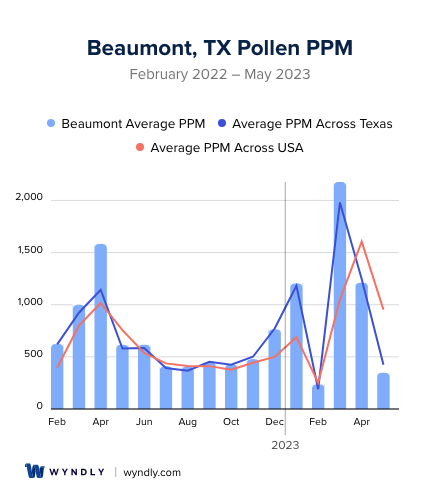
Beaumont, TX Pollen and Allergy Breakdown by Month
Grass
When is grass pollen highest in Beaumont, TX?
April has the highest grass pollen in Beaumont, TX with an average PPM of
When is grass pollen lowest in Beaumont, TX?
December has the lowest grass pollen in Beaumont, TX with an average PPM of
Tree
When is tree pollen highest in Beaumont, TX?
March has the highest tree pollen in Beaumont, TX with an average PPM of
When is tree pollen lowest in Beaumont, TX?
July has the lowest tree pollen in Beaumont, TX with an average PPM of
Weed
When is weed pollen highest in Beaumont, TX?
June has the highest weed pollen in Beaumont, TX with an average PPM of
When is weed pollen lowest in Beaumont, TX?
February has the lowest weed pollen in Beaumont, TX with an average PPM of
Beaumont, TX Pollen Monthly Breakdown by Pollen Type
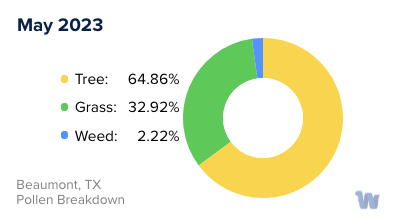
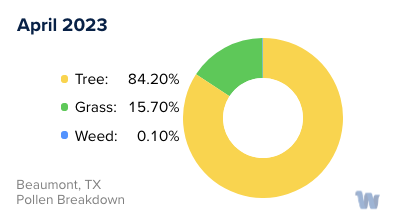
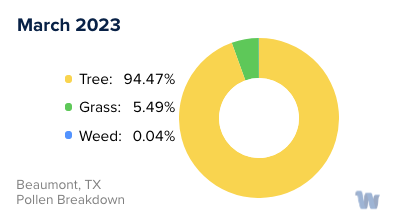
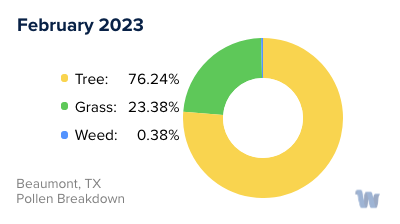
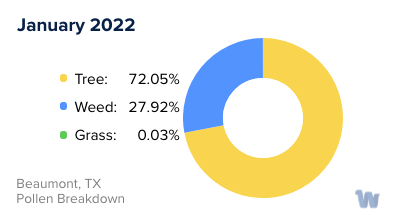
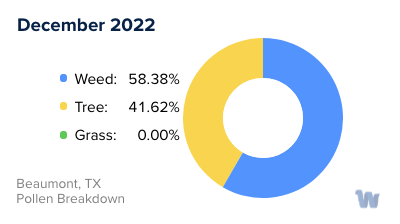
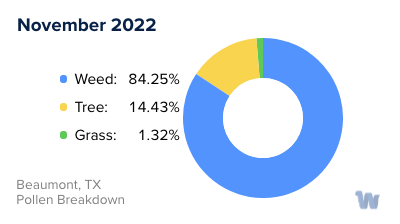

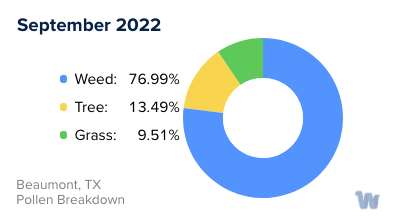
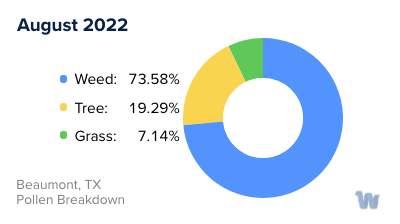
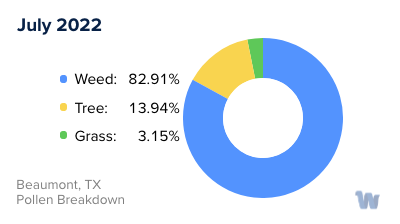
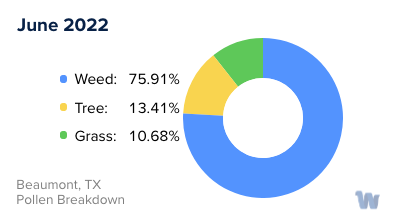
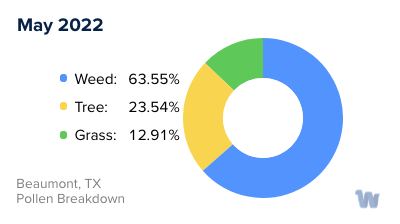
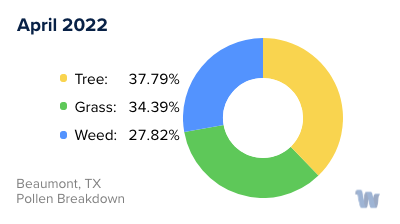
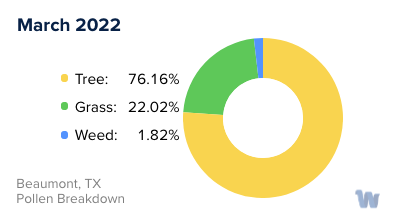
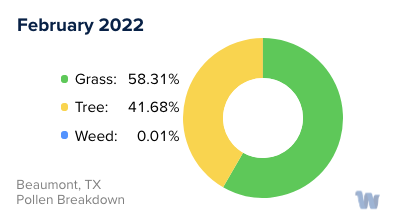
Pollen and Hay Fever in Beaumont, TX
In Beaumont, Texas, the dance of pollen and allergies is a seasonal affair that many residents are all too familiar with. Known for its lush greenery and blooming flora, Beaumont is home to a variety of pollen sources that can trigger allergies and hay fever.
Among the main culprits are tree pollen, grass pollen, and ragweed pollen. Each of these types of pollen can lead to an onslaught of allergic symptoms during their respective peak seasons, causing discomfort for many residents.
Tree pollen, in particular, often presents a significant concern. While the severity and timing can vary from year to year, it typically emerges as a problem when trees begin their annual growth cycle. This means that spring, with its warmer weather and increased sunlight, can be a prime time for tree pollen allergies.
Grass pollen also plays a significant role in the allergy landscape of Beaumont. The city's abundant grassy spaces can result in high concentrations of grass pollen, especially during the summer months. This means that as the city basks in the summer sun, many residents may find themselves grappling with hay fever symptoms.
Ragweed pollen is another allergen to note. While ragweed typically does not reach its peak until late summer or early fall, changes in climate can sometimes lead to earlier and more intense ragweed seasons.
Beyond these three main sources, Beaumont's flora includes a variety of other plants that can contribute to the city's pollen count. From sycamore trees to bermudagrass, many different types of vegetation can trigger allergies. As the weather warms up, mold and dust mites also become more prevalent, adding to the mix of potential allergens.
In Beaumont, the allergy season often spikes in the spring and summer. The warm and humid weather during these seasons creates ideal conditions for plants to thrive and spread their pollen. Ironically, the 'nice days' of clear skies and warm temperatures can be the worst times for pollen counts and allergen exposures. Drought conditions can further exacerbate the allergy season, as dry, dusty, and windy areas circulate pollen more effectively.
The allergy season in Beaumont typically kicks off in March or April and can last up to three months. However, the end of the allergy season is usually marked by a shift in weather patterns. As the temperatures begin to drop and plants start to dry up, the pollen count decreases, bringing relief to those with allergies and hay fever.
Through the dance of the seasons, Beaumont continues its cycle of growth, bloom, and rest, painting a picture of natural beauty that, while occasionally punctuated by the sneezes and sniffles of hay fever, remains a vibrant part of life in this Texas city.

